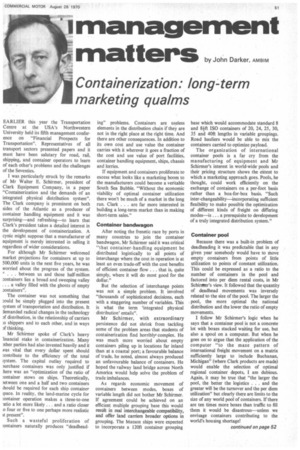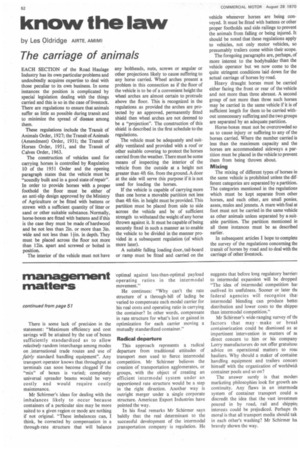'management
Page 53

Page 54

If you've noticed an error in this article please click here to report it so we can fix it.
matters by John Darker, AMBIM
Containerization: long-term marketing qualms
EARLIER this year the Transportation Centre at the USA's Northwestern University held its fifth management conference on "Financial Prospects for Transportation". Representatives of all transport sectors presented papers and it must have been salutary for road, rail, shipping, and container operators to learn of each other's problems and the challenges of the Seventies.
I was particularly struck by the remarks of Mr Walter E. Schirmer, president of Clark Equipment Company, in a paper "Containerization and the demands of an integrated physical distribution system". The Clark company is prominent on both sides of the Atlantic as a producer of container handling equipment and it was surprising—and refreshing—to learn that Clark's president takes a detailed interest in the development of containerization. A cynic might suppose that a manufacturer of equipment is merely interested in selling it regardless of wider considerations.
For although Mr Schirmer welcomed market projections for containers at up to 500,000 units in the next five years, he was worried about the progress of the system.
. . . between us and those half-million containers lies a broad and sweeping valley . . a valley filled with the ghosts of empty :containers".
The container was not something that could be simply plugged into the present ;ystem of transportation and distribution. It demanded radical changes in the technology A distribution, in the relationship of carriers :o shippers and to each other, and in ways A thinking.
Mr Schirmer spoke of Clark's heavy inancial stake in containerization. Many )ther parties had also invested heavily and it was vital that every dollar spent should contribute to the efficiency of the total ;ystem. The capital outlay required to iurchase containers was only justified if here was an "optimization of the ratio of container stows on ships. Theoretically, ntween one and a half and two containers ;hould be required for each ship container ;pace. In reality, the land-marine cycle for :ontainer operation makes a three-to-one ;atio a lot more likely .. . and a ratio closer o four or five to one perhaps more realistic it present".
Such a wasteful proliferation of ;ontainers naturally produces "deadhead
ing" problems. Containers are useless elements in the distribution chain if they are not in the right place at the right time. And there are other consequences. In addition to its own cost and use value the container carries with it wherever it goes a fraction of the cost and use value of port facilities, container handling equipment, ships, chassis and lorries.
If equipment and containers proliferate to excess what looks like a marketing boom to the manufacturers could become a veritable South Sea Bubble. "Without the economic viability of optimal container utilization there won't be much of a market in the long run. Clark . . are far more interested in building a long-term market than in making short-term sales."
Container bandwagon After noting the frenetic race by ports in many countries to join the container bandwagon, Mr Schirmer said it was critical "that container-handling equipment be distributed logistically to all points of interchange where the cost in operation is at least an even trade-off with the cost benefits of efficient container flow . . that is, quite simply, where it will do most good for the dollar."
But the selection of interchange points was not a simple problem. It involved "thousands of sophisticated decisions, each with a staggering number of variables. This is what the term 'integrated physical distribution' entails".
Mr Schirmer, with extraordinary persistence did not shrink from tackling some of the problem areas that students of containerization find horribly complex. He was much more worried about empty containers piling up in locations far inland than at a coastal port; a favourable balance of trade, he noted, almost always produced an unfavourable balance of containers. He hoped the railway land bridge across North America would help solve the problem of trade imbalances.
As regards economic movement of containers between modes, boxes of variable length did not bother Mr Schirmer. If agreement could be achieved on an efficient multiple grouping base this would result in real interchangeable compatibility, and offer land carriers broader options in grouping. The Matson ships were expected to incorporate a 120ft container grouping base which would accommodate standard 8 and 8-ft ISO containers of 20, 24, 25, 30, 35 and 40ft lengths in variable groupings. Road hauliers would be able to mix the containers carried to optimize payload.
The organization of international container pools is a far cry from the manufacturing of equipment and Mr Schirmer's interest in world-wide pools and their pricing structure shows the eXtent to which a marketing approach goes. Pools, he thought, could work efficiently on the exchange of containers on a per-foot basis rather than a box-for-box basis. "Such inter-changeability—incorporating sufficient flexibility to make possible the optimization of different kinds of freight on differing modes—is ... a prerequisite to development of a truly integrated distribution system."
Container pool Because there was a built-in problem of deadheading it was predictable that in any given year somebody would have to Move empty containers from points of little utilization to points of constant utilization. This could be expressed as a ratio to the number of containers in the pool and factored into per diem rental costs, in Mr Schirmer's view. It followed that the quantity of deadhead movements was inversely related to the size of the pool. The larger the . pool, the more optimal the national distribution and the lower the ratio of empty movements.
I follow Mr Schirmer's logic when he says that a container pool is not a concrete lot with boxes stacked waiting for use, but also a spool on a computer. But when he goes on to argue that the application of the computer "to the maze pattern of international freight movement on a matrix sufficiently large to include Buchanan, Michigan" (where Clark products are made) would enable the selection of optimal regional container depots, I am dubious. Again, it may be true that "the larger the pool, the better the logistics . . . and the greater will be the turnover and the per diem utilization" but clearly there are limits to the size of any world pool of containers. If there are ten times more boxes than traffic to fill them it would be disastrous—unless we envisage containers contributing to the world's housing shortage!
There is some lack of precision in the statement: "Maximum efficiency and cost savings will be attained by the use of boxes sufficiently standardized as to allow relatively random interchange among modes on international trade routes and use of fairly standard handling equipment". Any transport operator knows that throughput at terminals can soon become clogged if the "mix" of boxes is varied; completely universal spreader beams would be very costly and would require costly maintenance.
Mr Schirmer's ideas for dealing with the imbalances likely to occur because containers of a particular size may be more suited to a given region or mode are nothing if not original. "These imbalances can, I think, be corrected by compensation in a through-rate structure that will balance optimal against less-than-optimal payload operating ratios in the intermodal movement."
He continues: "Why can't the rate structure of a through-bill of lading be varied to compensate each modal carrier for his real costs and operating ratio in carrying the container? In other words, compensate in rate structure for what's lost or gained in optimization for each carrier moving a mutually standardized container."
Racked departure This approach represents a radical departure from traditional attitudes of transport men used to fierce intermodal competition. Mr Schirmer believes the creation of transportation agglomerates, or groups, with the object of creating an efficient intermodal system under an apportioned rate structure would be a step in the right direction. Another way is outright merger under A single corporate structure. American Export Industries have pointed the way.
In his final remarks Mr Schirmer says baldly that the real determinant to the successful development of the intermodal transportation company is regulation. He suggests that before long regulatory barriert to intermodal expansion will be dropped "The idea of intermodal competition ha! outlived its usefulness. Sooner or later du federal agencies will recognize thai intermodal blending can produce bette distribution and lower costs to the shippe than intermodal competition."
Mr Schirmer's wide-ranging survey of tht factors that may make or breal containerization could be dismissed as at impertinent intervention in matters of m direct concern to him or his company Lorry manufacturers do not offer gratuitou: advice on operational matters to row hauliers. Why should a maker of containe handling equipment and trailers concert himself with the organization of worldwict container pools and so on?
The answer surely is that moden marketing philosophies look for growth an continuity. Any flaws in an intermoda system of container transport could st discredit the idea that the vast investmen poured in by road, rail and shippin; interests could be prejudiced. Perhaps th moral is that all transport media should talc in each other's washing? Mr Schirmer ha bravely shown the way.
































































































